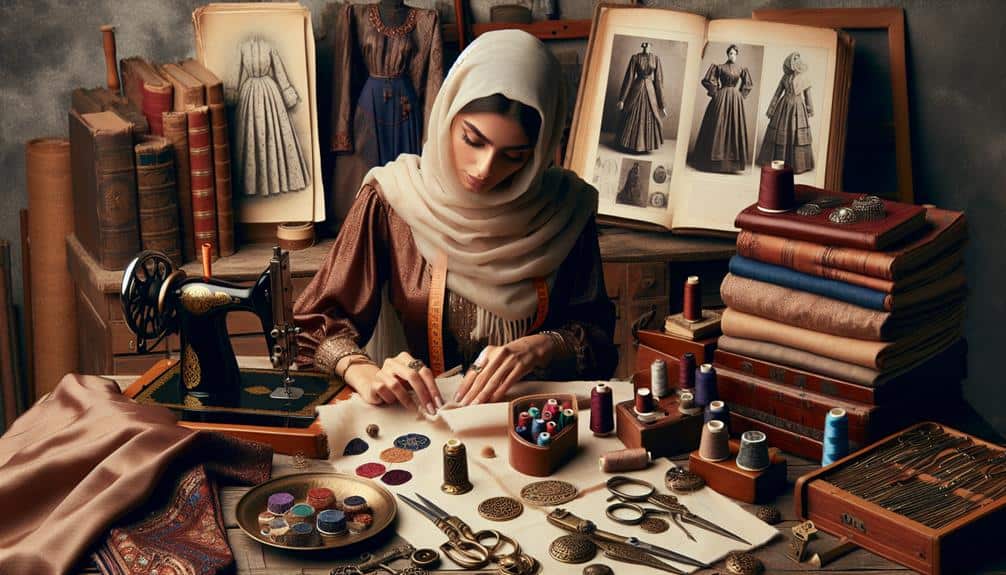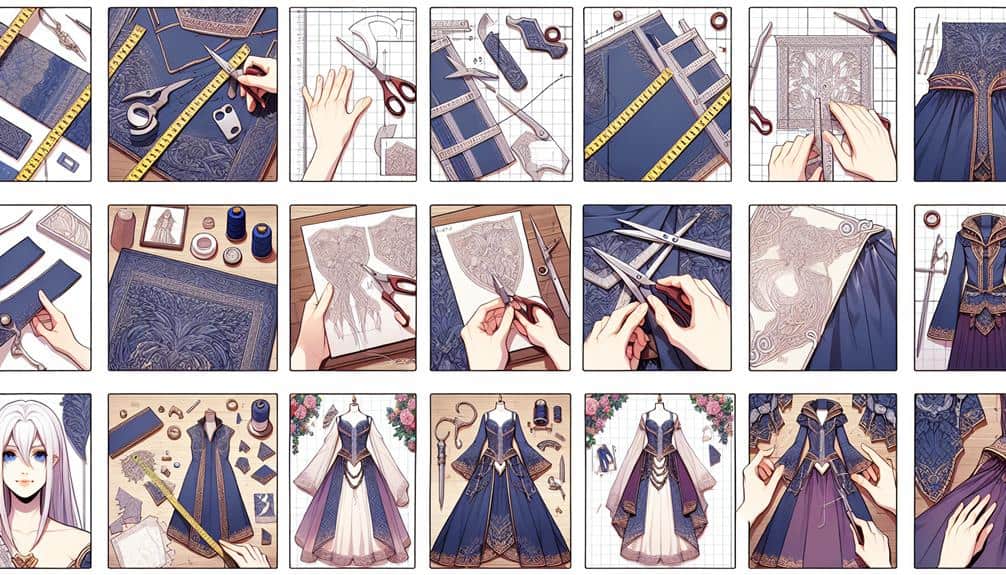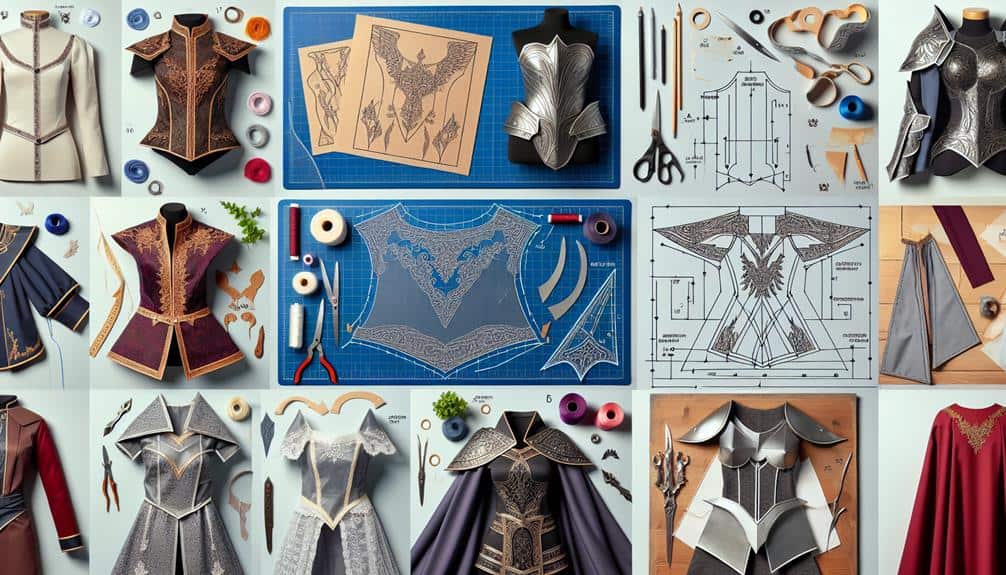So, you think throwing on a corset and a frilly dress instantly transports you back in time for your historical cosplay? Think again. Authentic historical costume design involves a meticulous process that goes beyond the surface.
From researching historical periods to tailoring for an authentic fit, there are important steps to guarantee your cosplay truly captures the essence of the era. Stay tuned to uncover the secrets behind creating a historically accurate costume that will make you stand out at your next event.
Key Takeaways
- Prioritize historical accuracy in fabric selection and details.
- Include authentic accessories for a complete look.
- Focus on meticulous tailoring for an authentic fit.
- Research extensively to capture iconic styles of the chosen era.
Researching Historical Periods
When delving into historical cosplay costume design, an important step is researching various historical periods to guarantee accuracy and authenticity in your creations. Historical fashion is rich in detail, with each period having specific characteristics that define its style. Understanding these period-specific details is essential in creating a costume that truly captures the essence of the era you're portraying.
For instance, if you're designing a costume from the Victorian era, you'd need to pay attention to elements such as the use of corsets, bustles, and intricate lace details. On the other hand, if you're exploring the Roaring Twenties, you'd focus on the shift towards looser silhouettes, flashy embellishments, and the iconic flapper style.
Choosing Authentic Fabrics
To safeguard historical accuracy in your cosplay costume design, how can you select authentic fabrics that align with the specific time period you're recreating? When choosing fabrics for your historical cosplay costume, it's essential to take into account the materials that were commonly used during the era you're portraying. Here are some tips to help you select authentic fabrics:
- Silk Brocade: For luxurious and ornate costumes from periods like the Renaissance or Baroque era, silk brocade is an excellent choice. Its intricate patterns and rich texture can add a touch of elegance to your outfit.
- Linen Blends: Linen blends are ideal for recreating costumes from ancient civilizations like Ancient Greece or Rome. Linen was a popular fabric due to its breathability and durability, making it suitable for warm climates.
- Wool Crepe: If you're designing a costume from the Victorian era or the early 20th century, wool crepe can be a good option. This fabric drapes well and has a slightly textured surface, perfect for creating tailored garments.
- Historical Accuracy: Remember, historical accuracy is key when selecting fabrics. Research the fabric choices of the time period you're focusing on to make sure your costume is authentic and visually appealing.
Incorporating Accurate Accessories
In creating a historically accurate cosplay costume, the incorporation of authentic accessories plays a pivotal role in completing the overall look. Accessorizing details are vital for achieving a faithful representation of a specific time period or culture. These accessories can range from jewelry and handbags to hats and footwear, each carrying its own cultural significance and historical references.
To guarantee accuracy, meticulous attention should be paid to the crafting techniques used in making these accessories. For instance, if portraying a character from the Victorian era, incorporating lace gloves and a parasol can add an authentic touch to the ensemble. Researching the historical context of the accessories is essential for understanding their role in society and how they complement the overall costume.
Prioritizing Historical Accuracy
To enhance the authenticity of your historical cosplay costume, emphasizing historical accuracy should be your primary focus, ensuring every detail reflects the specific time period or culture you aim to portray. Achieving costume authenticity involves a blend of design techniques and historical accuracy while allowing room for costume creativity.
Here are some key points to contemplate:
- Research Extensively: Delve into historical resources, paintings, photographs, and fashion plates to understand the clothing styles, fabrics, and accessories of the era you're recreating.
- Fabric Selection: Opt for fabrics that were commonly used during the period. Avoid modern materials that may not have existed or been accessible at that time.
- Attention to Detail: Pay close attention to small details like trims, buttons, and closures. These elements can make a significant difference in the overall authenticity of your costume.
- Period-appropriate Silhouettes: Ensure that the shape and silhouette of your costume align with the fashion trends of the chosen historical era. Tailoring plays a critical role in achieving the right fit and look.
Tailoring for Authentic Fit
Achieving an authentic fit in historical cosplay costumes requires meticulous tailoring to guarantee the costume aligns accurately with the fashion trends of the chosen era. Tailoring techniques play a significant role in ensuring that the costume fits the wearer impeccably, reflecting the styles of the past. When constructing a historical cosplay costume, it's essential to pay close attention to details such as silhouette, fabric drape, and seam placement to achieve an authentic look.
Costume construction techniques like flat-felling seams, hand-stitched hems, and proper interfacing can elevate the overall quality of the garment and contribute to a more historically accurate fit. Additionally, understanding the undergarments and foundation garments of the era can aid in achieving the right silhouette and fit for the outer costume layers.
Frequently Asked Questions
How Can I Ensure My Historical Cosplay Costume Is Culturally Accurate in Terms of Etiquette and Social Norms?
To guarantee cultural accuracy in your historical cosplay costume regarding etiquette and social norms, research extensively. Pay attention to details such as attire, mannerisms, and customs. Cultural sensitivity is key in portraying the era authentically.
Are There Any Specific Guidelines for Incorporating Historically Accurate Hairstyles and Makeup Into My Costume?
To guarantee historically accurate hairstyles and makeup, research accuracy is key. Immerse yourself in period-appropriate styling to elevate your look. Pay attention to details like hair accessories, makeup trends, and cultural influences for an authentic portrayal.
What Resources Can I Consult to Learn More About the Historical Context and Significance of the Clothing I Am Recreating?
To learn more about the historical context and significance of the clothing you're recreating, research materials, online forums, museum visits, and historical documentaries are valuable resources. They provide in-depth knowledge and authentic inspiration for your costume design.
How Can I Accurately Portray the Social Status or Occupation of the Character I Am Cosplaying Through Their Clothing?
To accurately portray the social status or occupation of the character you're cosplaying, focus on details like fabric quality, accessories, and overall style. Research the typical attire of that profession or social class for costume design tips.
Are There Any Tips for Sourcing or Creating Historically Accurate Undergarments to Complete My Costume?
When creating historically accurate undergarments for your cosplay, sourcing materials and creating patterns are key. Start by researching fabrics and construction methods typical for the era you are portraying. This attention to detail will enhance your overall costume authenticity.


